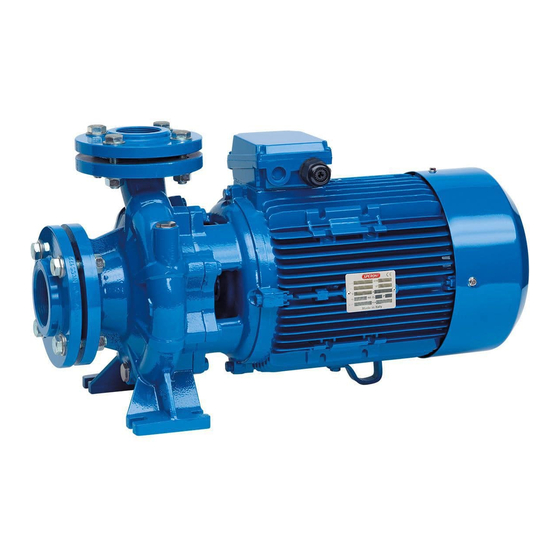
Summary of Contents for SPERONI CS Series
- Page 1 Monoblock centrifugal pumps Elettropompe centrifughe monoblocco Operating instructions Libretto istruzione Инструкция по зксплуaтaции...
- Page 2 INSTRUCTIONS FOR THE INSTALLATION AND USE OF ELECTROPUMPS 1. General Warning: This manual is meant to provide the user with the For operation in hot damp environments, the pump essential information required for installing, using and should not be installed orientated to different directions servicing the pumps.
- Page 3 The head losses can be read from the diagram shown in our catalogue, and in order to reduce them to a is the vapour pressure of the liquid at the operating minimum - mainly where suction is remarkable (over temperature, expressed in metres of liquid. hpv is 4-5 metres) or when operating at the highest flow the quotient between the vapour pressure and the rates - it is advisable to use a section pipe larger than...
- Page 4 INSTRUCTIONS FOR THE INSTALLATION AND USE OF ELECTROPUMPS The suction line should be slightly inclined up towards 4.2 Checking the direction of rotation of the the pumps and any reducers should be eccentric electric pumps with three phase motors (see fig. 1) to prevent air locks. The direction of rotation may be checked before the In any such installations where the operating condi- pump is fitted with the liquid to be pumped, provided...
- Page 5 In such instance the maximum rated flow rate should 7. Connection be reduced, to avoid the overload protection tripping The six terminal arrangement with delta ( ) or star too often. ) connection allows for the motors. – The pump should not be subjected to more than 20 startings per hour, to avoid excessive thermal stress on the motor.
- Page 6 INSTRUCTIONS FOR THE INSTALLATION AND USE OF ELECTROPUMPS 8. Fault finding chart: problems, possible causes and remedies Problem How to check Remedy A - Make sure that power supply is connected. 1 Motor does not start. B - Check for any blown fuses. B - Replace fuse with new one.
- Page 7 8. Fault finding chart: problems, possible causes and remedies Problem How to check Remedy A - Ascertain whether the protection device is A - Correct setting. set to a value lower than the motor full load requirements. B - One phase is missing due to faults in B - Clean and reset contact or contacts or supply cable.
- Page 8 ISTRUZIONI PER L’INSTALLAZIONE E L’UTILIZZO DELLE ELETTROPOMPE 1. Generalità Avvertenza: Se l’ambiente in cui l’elettropompa deve operare è Col presente manuale si intende fornire all’utilizzatore particolarmente caldo e umido si sconsiglia di installare le informazioni indispensabili per l’installazione, l’uso l’elettropompa con orientamenti diversi da quello e la manutenzione delle pompe.
- Page 9 Le perdite di carico sono rilevabili dal diagramma riportato sul catalogo e, allo scopo di ridurre la loro è la perdita di carico nella tubazione d’aspirazione e entità al minimo, specialmente nei casi di aspirazione negli accessori di cui essa è corredata quali: raccordi, notevoli (oltre i 4-5 m) o nei casi di funzionamento valvola di fondo, saracinesche, curve, ecc.
- Page 10 ISTRUZIONI PER L’INSTALLAZIONE E L’UTILIZZO DELLE ELETTROPOMPE Il tubo di aspirazione dovrà avere una leggera pen- 4.2 Controllo del senso di rotazione denza positiva verso la pompa e le eventuali riduzioni nelle elettropompe con motore trifase dovranno essere il tipo eccentrico (vedere figura n. Il controllo del senso di rotazione può...
- Page 11 Vengono inoltre messe in risalto le seguenti osserva- 7. Collegamento zioni: La disposizione a 6 morsetti consente, con il collegamento degli stessi a triangolo ( ) o a stella – Per liquidi a temperature superiori a quelle di prova ( ), l’alimentazione del motore. la prevalenza manometrica in mandata diminuisce in rapporto al peso volumico del liquido.
- Page 12 ISTRUZIONI PER L’INSTALLAZIONE E L’UTILIZZO DELLE ELETTROPOMPE 8. Inconvenienti, probabili cause e rimedi Inconveniente Ricerca della causa Rimedi A - Controllare che vi sia energia elettrica di 1 Il motore alimentazione. non parte B - Sostituire il fusibile. B - Verificare se un fusibile è bruciato. e non genera N.B.
- Page 13 8. Inconvenienti, probabili cause e rimedi Inconveniente Ricerca della causa Rimedi A - Vedere se la taratura della protezione è A - Correggere la taratura. stata eseguita ad un valore di corrente più basso di quello di assorbimento del motore a pieno carico.
- Page 20 Informazioni sullo smaltimento delle apparecchiature elettriche ed elettroniche in ottemperanza alla direttiva 2002/96 CE (RAEE). Attenzione: per smaltire il presente prodotto non utilizzare il normale bidone della spazzatura. Le apparecchiature elettriche ed elettroniche usate devono essere gestite a parte ed in conformità alla legislazione che richiede il trattamento, il recupero e il riciclaggio adeguato dei suddetti prodotti.
- Page 21 Informatie over het milieuvriendelijk afvoeren van elektronische installatie volgens richtlijn 2002/96 CE (RAEE) Opgepast: product niet meegeven met normaal huisvuil ophaling. Gebruikte elektrische en elektronische apparaten moeten apart worden verwerkt volgens de wet van het de verwerking, hergebruiking en recyclage van het product. Overeenkomstig de regeringen die in de lidstaten worden toegepast, de privé...
- Page 22 N O T E...
- Page 23 D I C H I A R A Z I O N E D I C O N F O R M I T À EC declaration of conformity We declare that articles present in this handbook comply with the following Directives: •...

















Need help?
Do you have a question about the CS Series and is the answer not in the manual?
Questions and answers